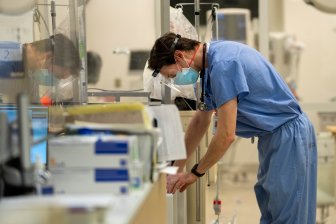The Canadian Museum of Nature is making it all the more easier to ensure that future researchers have access to biological samples of the world’s animal and plant species for years to come.

On Tuesday morning the museum unveiled its new cryobank lab in Gatineau where six new cylindrical freezers will each house over 31,000 samples from around the world, totaling approximately 186,000 samples.
The new freezers are cooled to a brisk -170 C which, according to the museum, is the temperature where movement in the DNA molecules is negligible which allows for permanent preservation without the samples breaking down over time.
The first samples stored so far are about 15,000 plant samples from around the world, many of which were taken from the Canadian Arctic.
According to Roger Bull, head of operations at the facility, the focus of these tanks is to help preserve and research biodiversity of today’s plants and animals. No human DNA will be preserved as facilities already exist in abundance for that and currently no ancient samples will be stored in the freezers. The oldest samples preserved date back to the 1990s.
The samples preserved by the freezers will only be accessible by staff at the facility but Bull says they are implementing an online platform where researchers from anywhere can fill out a form to request samples from the facility for their own research.
- Ontario takes action against chemical plant after Aamjiwnaang First Nation residents fell ill
- High benzene levels detected near Ontario First Nation for weeks, residents report sickness
- Beijing orders Apple to pull WhatsApp, Threads from its China app store
- Fishing vessel with crane, net arrives in Zeballos for orca calf rescue
According to Bull, each freezer costs approximately $50,000 and is completely self-sufficient. There is no need for insulated piping to transfer liquid nitrogen and the pressurized nitrogen used in the system never needs to be replaced. In the case of a power outage, the freezers are able to keep the temperatures at -150 C for up to seven days. The program is completely funded through philanthropic donations.
A large portion of the tissue samples preserved right now were donated by Parks Canada and according to Bull, the animals do not need to be killed or tranquillized in order to receive a sample. Instead, a dart is shot into the animal and it quickly falls out, taking with it a skin sample for preservation.
Dr. Mark Graham, the VP of research and collections at the museum, says that future samples will come from all over the country, not just from the museum and Parks Canada.
“We expect the collections to grow over time,” said Graham. “Samples will come from not only our museum’s national research efforts but also from samples donated by universities, government agencies or other scientific initiatives needing a permanent repository that is accessible for scientific study.”
An open house will be held on Oct. 13 at the Gatineau facility and people will be able to check out the new freezers and inquire more about the new program.




Comments